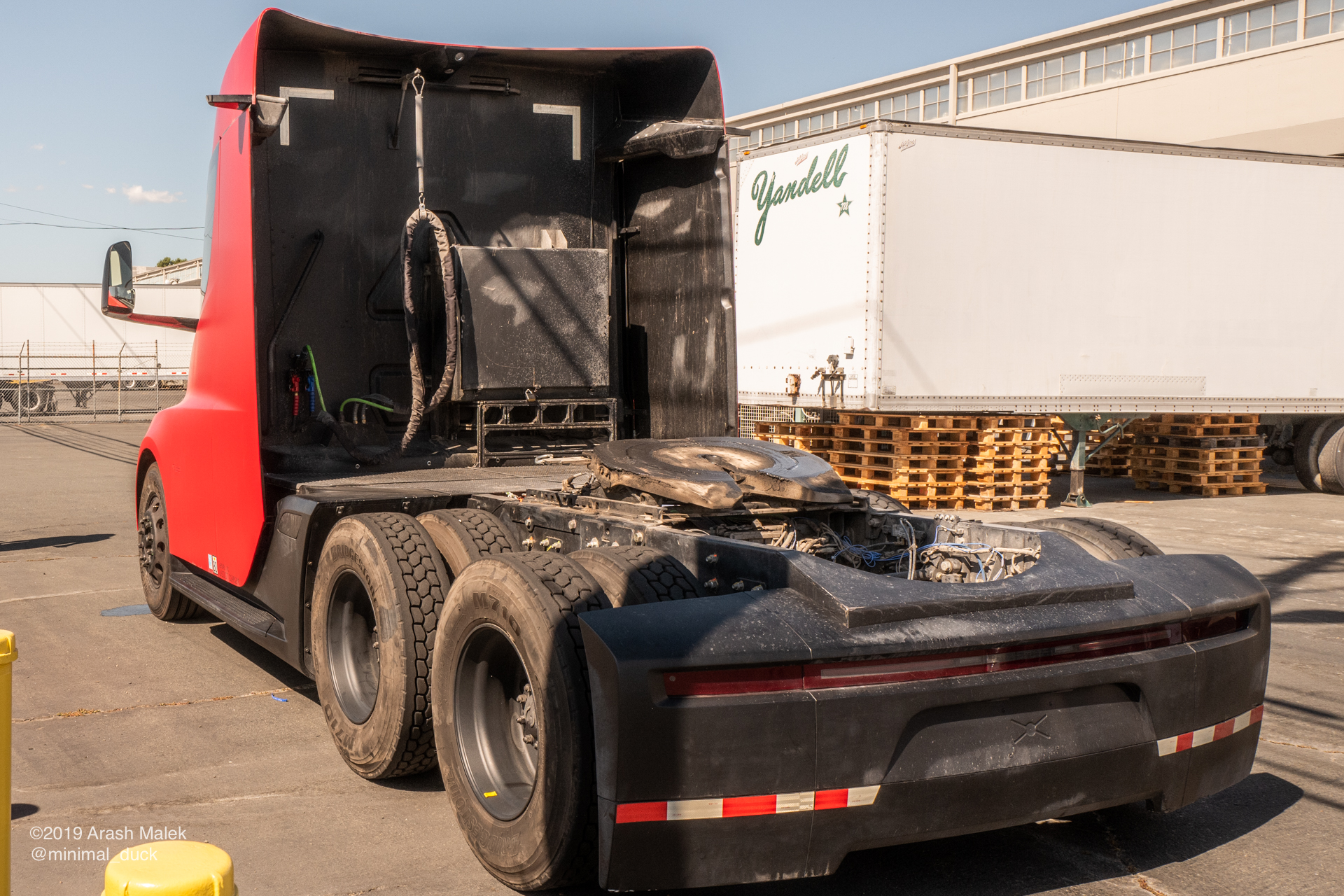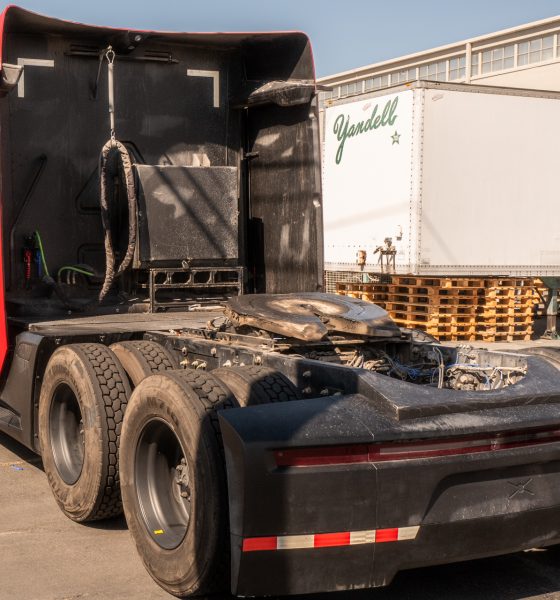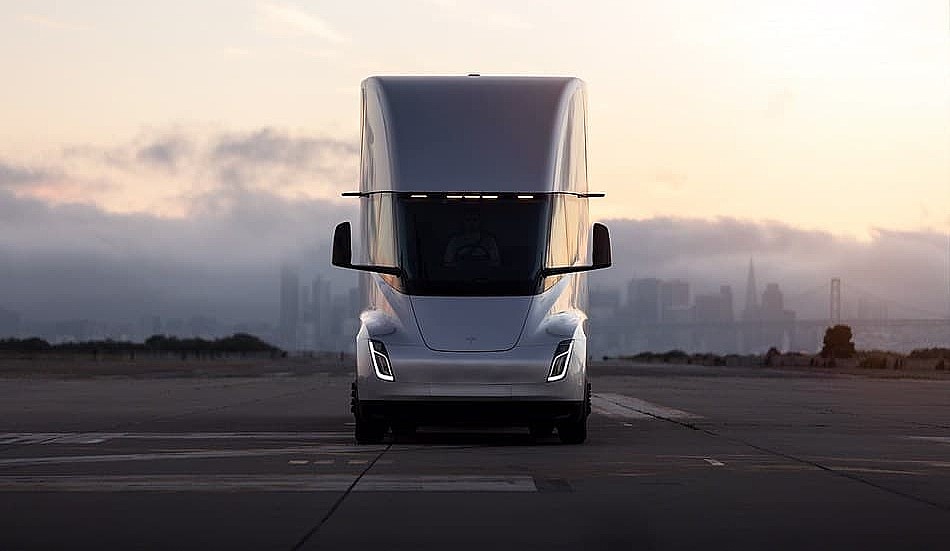

News
The Tesla Semi’s economical advantage is frighteningly underestimated
The Tesla Semi has its own fair share of critics, and even today, some notable voices such as Microsoft co-founder Bill Gates believe that the Class 8 all-electric truck is not feasible. When one looks at the currently available information about the upcoming vehicle, however, one would see that the Tesla Semi is vastly underestimated.
One of the key criticisms surrounding the Tesla Semi is its weight, which skeptics would claim is far too much to be economically viable. Tesla has not shared any specifics surrounding the Semi’s weight, though the company did note that the vehicle consumes less than 2 kWh per mile. As noted by the OBF in a YouTube video, this would translate to the Semi likely having a battery that’s roughly around 600 kWh to 1,000 kWh, depending on whether the vehicle features a 300 or 500-mile range.

Considering that Tesla’s 100 kWh batteries typically weigh around 1,300 lbs, it could then be inferred that the Semi’s battery pack would weigh around 7,800 to 13,000 lbs. This is assuming that the Semi is equipped with the same batteries that Tesla had when the Class 8 truck was unveiled. If Tesla’s 4680 cells are involved, this weight could be optimized further, considering that the company’s custom batteries are lighter and more powerful.
Traditional diesel semitrailers typically weigh around 15,000 to 25,000 lbs, which means that the Semi would likely be at a disadvantage weight-wise. To address this disadvantage, Tesla would have to ensure that the rest of the Semi is made with light and durable materials. Tesla’s extensive experience as an EV maker plays a huge part in this, as the company could use all that it has learned during the design and rollout of the Model S,3,X,Y lineup to optimize the Semi’s weight.
If Tesla’s estimates are correct and its new 4680 batteries are lighter, and if the electric car maker uses innovations such as a structural battery pack on the Semi, the weight disadvantage of the Class 8 truck against diesel rivals becomes much smaller. Couple this with the fact that the Semi’s electric motors weigh far less than a large diesel engine and the all-electric Class 8 long hauler becomes a very compelling alternative to traditional semitrailers. Even the Semi’s higher price, which is expected to start at $180,000, becomes a moot point considering that electric vehicles need far less maintenance over their lifetime.
But this is not all. The Semi also stands to benefit from Tesla’s work with its Full Self-Driving suite, whose inner-city driving features are currently being rolled out to its initial batch of testers. Features such as Navigate on Autopilot, which would be incredibly useful for operators of the Tesla Semi, have already become refined over the years, and it would likely only take a matter of time before inner-city driving reaches the same state. When it does, capabilities that are unique to the Semi, such as its Convoy Mode, would likely become a “killer feature” that would make the vehicle a no-brainer against the competition.
Watch the OBF’s take on the economics of the Tesla Semi in the video below.
Don’t hesitate to contact us for news tips. Just send a message to tips@teslarati.com to give us a heads up.

News
Nvidia CEO Jensen Huang explains difference between Tesla FSD and Alpamayo
“Tesla’s FSD stack is completely world-class,” the Nvidia CEO said.

NVIDIA CEO Jensen Huang has offered high praise for Tesla’s Full Self-Driving (FSD) system during a Q&A at CES 2026, calling it “world-class” and “state-of-the-art” in design, training, and performance.
More importantly, he also shared some insights about the key differences between FSD and Nvidia’s recently announced Alpamayo system.
Jensen Huang’s praise for Tesla FSD
Nvidia made headlines at CES following its announcement of Alpamayo, which uses artificial intelligence to accelerate the development of autonomous driving solutions. Due to its focus on AI, many started speculating that Alpamayo would be a direct rival to FSD. This was somewhat addressed by Elon Musk, who predicted that “they will find that it’s easy to get to 99% and then super hard to solve the long tail of the distribution.”
During his Q&A, Nvidia CEO Jensen Huang was asked about the difference between FSD and Alpamayo. His response was extensive:
“Tesla’s FSD stack is completely world-class. They’ve been working on it for quite some time. It’s world-class not only in the number of miles it’s accumulated, but in the way it’s designed, the way they do training, data collection, curation, synthetic data generation, and all of their simulation technologies.
“Of course, the latest generation is end-to-end Full Self-Driving—meaning it’s one large model trained end to end. And so… Elon’s AD system is, in every way, 100% state-of-the-art. I’m really quite impressed by the technology. I have it, and I drive it in our house, and it works incredibly well,” the Nvidia CEO said.
Nvidia’s platform approach vs Tesla’s integration
Huang also stated that Nvidia’s Alpamayo system was built around a fundamentally different philosophy from Tesla’s. Rather than developing self-driving cars itself, Nvidia supplies the full autonomous technology stack for other companies to use.
“Nvidia doesn’t build self-driving cars. We build the full stack so others can,” Huang said, explaining that Nvidia provides separate systems for training, simulation, and in-vehicle computing, all supported by shared software.
He added that customers can adopt as much or as little of the platform as they need, noting that Nvidia works across the industry, including with Tesla on training systems and companies like Waymo, XPeng, and Nuro on vehicle computing.
“So our system is really quite pervasive because we’re a technology platform provider. That’s the primary difference. There’s no question in our mind that, of the billion cars on the road today, in another 10 years’ time, hundreds of millions of them will have great autonomous capability. This is likely one of the largest, fastest-growing technology industries over the next decade.”
He also emphasized Nvidia’s open approach, saying the company open-sources its models and helps partners train their own systems. “We’re not a self-driving car company. We’re enabling the autonomous industry,” Huang said.
Elon Musk
Elon Musk confirms xAI’s purchase of five 380 MW natural gas turbines
The deal, which was confirmed by Musk on X, highlights xAI’s effort to aggressively scale its operations.

xAI, Elon Musk’s artificial intelligence startup, has purchased five additional 380 MW natural gas turbines from South Korea’s Doosan Enerbility to power its growing supercomputer clusters.
The deal, which was confirmed by Musk on X, highlights xAI’s effort to aggressively scale its operations.
xAI’s turbine deal details
News of xAI’s new turbines was shared on social media platform X, with user @SemiAnalysis_ stating that the turbines were produced by South Korea’s Doosan Enerbility. As noted in an Asian Business Daily report, Doosan Enerbility announced last October that it signed a contract to supply two 380 MW gas turbines for a major U.S. tech company. Doosan later noted in December that it secured an order for three more 380 MW gas turbines.
As per the X user, the gas turbines would power an additional 600,000+ GB200 NVL72 equivalent size cluster. This should make xAI’s facilities among the largest in the world. In a reply, Elon Musk confirmed that xAI did purchase the turbines. “True,” Musk wrote in a post on X.
xAI’s ambitions
Recent reports have indicated that xAI closed an upsized $20 billion Series E funding round, exceeding the initial $15 billion target to fuel rapid infrastructure scaling and AI product development. The funding, as per the AI startup, “will accelerate our world-leading infrastructure buildout, enable the rapid development and deployment of transformative AI products.”
The company also teased the rollout of its upcoming frontier AI model. “Looking ahead, Grok 5 is currently in training, and we are focused on launching innovative new consumer and enterprise products that harness the power of Grok, Colossus, and 𝕏 to transform how we live, work, and play,” xAI wrote in a post on its website.
Elon Musk
Elon Musk’s xAI closes upsized $20B Series E funding round
xAI announced the investment round in a post on its official website.

xAI has closed an upsized $20 billion Series E funding round, exceeding the initial $15 billion target to fuel rapid infrastructure scaling and AI product development.
xAI announced the investment round in a post on its official website.
A $20 billion Series E round
As noted by the artificial intelligence startup in its post, the Series E funding round attracted a diverse group of investors, including Valor Equity Partners, Stepstone Group, Fidelity Management & Research Company, Qatar Investment Authority, MGX, and Baron Capital Group, among others.
Strategic partners NVIDIA and Cisco Investments also continued support for building the world’s largest GPU clusters.
As xAI stated, “This financing will accelerate our world-leading infrastructure buildout, enable the rapid development and deployment of transformative AI products reaching billions of users, and fuel groundbreaking research advancing xAI’s core mission: Understanding the Universe.”
xAI’s core mission
Th Series E funding builds on xAI’s previous rounds, powering Grok advancements and massive compute expansions like the Memphis supercluster. The upsized demand reflects growing recognition of xAI’s potential in frontier AI.
xAI also highlighted several of its breakthroughs in 2025, from the buildout of Colossus I and II, which ended with over 1 million H100 GPU equivalents, and the rollout of the Grok 4 Series, Grok Voice, and Grok Imagine, among others. The company also confirmed that work is already underway to train the flagship large language model’s next iteration, Grok 5.
“Looking ahead, Grok 5 is currently in training, and we are focused on launching innovative new consumer and enterprise products that harness the power of Grok, Colossus, and 𝕏 to transform how we live, work, and play,” xAI wrote.








